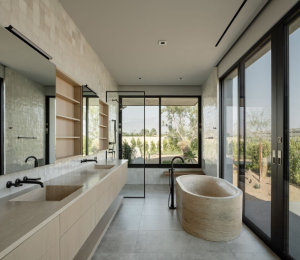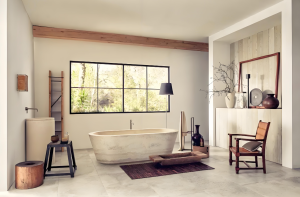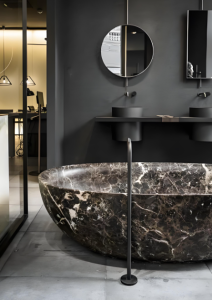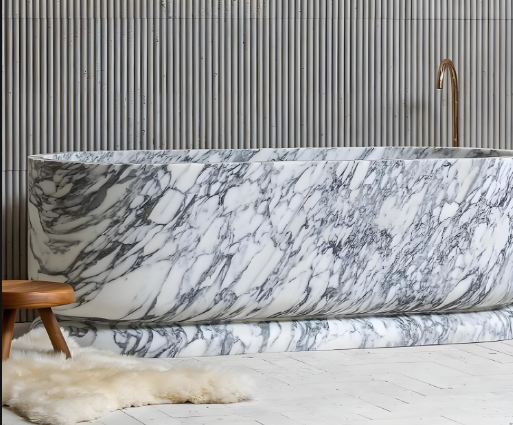As a high-end decorative material, bathroom stone can not only enhance the beauty of the space, but also add a natural atmosphere to the bathroom. But bathroom stone’s natural qualities call for particular care both in use and maintenance. Together with advice on how best to maintain these stones, the following is a thorough introduction to often used bathroom stones and their features.

Bathroom stone can enhance the beauty of the space
01 Bathroom Stone and Its Performance
With the continuous improvement of people’s living standards, laying natural stone in the bathroom has gradually become a fashion. The color, pattern and texture of the stone are often selected based on the subjective feelings of the owner. The decorative stones commonly used in the bathroom are mainly marble and granite.
Nowadays, people generally like to use marble as the decorative countertop of the washbasin, while the floor and wall of the bathroom are decorated with more high-end natural stone, which adds a bit of elegance to the bathroom. Marble is also called metamorphic or recrystallized limestone.
Real marble is a calcite metamorphic rock with a crystalline structure. Marble is derived from limestone according to the metamorphism of regional stone. It generally contains large, rough crystals, of which calcite accounts for more than 99%. The crystals are visible to the naked eye, especially on its cross section.
The main components of marble are calcite and calcium carbonate, and the Mohs hardness value is about 4.5. Polished marble is suitable for paving on vertical surfaces (such as walls). In addition to its function of protecting the wall, its other natural characteristics, such as smooth surface, beautiful color and natural texture, are very suitable for beautifying the bathroom environment.
However, its disadvantages are that it is relatively soft, has poor acid and alkali resistance and weathering resistance, is easily contaminated by oil, water and other liquids, is easily scratched, and is not wear-resistant. Almost all cleaning agents and stains containing acids and alkalis will damage marble. For example, vinegar, lemon juice, orange juice, cola juice, fruit juice, etc. used in daily life are acidic. If a small amount is spilled on the surface of marble, it should be wiped and cleaned immediately. If it stays a little longer, the marble will be damaged and lose its luster.
If used in the bathroom, daily maintenance and protection must be done. Because marble is easier to renovate and has a lower cost, it can be renovated at any time after being used on a larger area of the floor. Granite is mainly composed of quartz (35%), feldspar (45%) and feldspar. The Mohs hardness value is about 6.5, the color is usually darker, and some also contain a very small amount of calcite. Crystals with mineral particles can be seen on the surface.
Granite can also be divided into many types according to the proportion of quartz, mica and feldspar. The advantages of granite are high hardness, acid and alkali resistance, wear resistance, strong weathering resistance, suitable for the exterior walls, floors, corridors, stairs, kitchens, bathrooms and other parts of buildings, and easier to maintain than marble.
However, its color tone and texture are relatively simple, and once it is worn out, it has poor repairability. Therefore, it is more suitable for bathroom countertops, kitchen stoves, window sills, sanitary walls and other places that may be exposed to acidic solvents.
When choosing the floor, we should consider the poor repairability of granite, the difficulty and high cost of renovation, the uneven interface when paving, or the difficulty of handling it after being worn out. Among polished stones, granite is the hardest and can be used in places with high pressure.
But its surface also has pores and can be contaminated. Some stones are naturally suitable for use in bathrooms. For example, marble with a harder material and higher density is more suitable than marble with a softer material and higher water absorption. Light-colored stones are more resistant to slight soapy water pollution than dark-colored stones. Therefore, it is recommended not to use green serpentine and black marble in the bathroom, so that the possibility of stone surface pollution is relatively small.

Using natural stone in the bathroom
02 Bathroom stone maintenance
Although natural stone is a high-end decorative material with natural beauty, due to its naturalness and the diversity of mineral structure, the stone itself will have defects and problems to varying degrees. The seemingly hard stone is actually very delicate and needs to be carefully cared for during paving and use.
Because the bathroom has a specific function of bathing and there is a lot of water vapor, the laid stone is very easy to be polluted if it is not properly maintained. Common pollution is caused by mold, dirt and bacteria. The surface of the stone often becomes dull and produces cloud-like circles of white stains.
Another problem encountered in daily life is the pollution of bathroom marble by soap and shampoo. The damaged stone surface is rough and dull. The originally beautiful and smooth polished surface loses its mirror luster, cannot clearly reflect the scenery, and the patterns become blurred.
To avoid this situation, it is best to use dye-free shampoo, and soap and shampoo without artificial colors. Some medical shampoos can also damage the stone. If possible, it is best to avoid using such products in bathrooms decorated with marble.
03 Polishing of bathroom stone
People often encounter such problems:
The marble in the bathroom becomes dark, severely damaged, and the surface gloss disappears. If you encounter such a situation, you need to polish the surface. High-quality polishing agents can be bought in large domestic building materials supermarkets.
Polishing agents are usually composed of two components: polishing powder and polishing liquid. The polishing powder contains fine particles of oxides such as aluminum oxide or tin oxide. The main component of the polishing liquid is surfactant and does not contain acid.
Manual polishing is suitable for processing small surfaces, while machine polishing is used for large areas with damaged and dull surfaces. If it is a family bathroom, you can do it yourself (DIY). When doing this, mix the two components (polishing powder and polishing liquid) into a paste, apply it to the surface, and polish it with a white polishing cotton pad to achieve very good results.
If there is no special polishing pad at home, you can also use the non-woven fabric commonly used in the kitchen with polishing products to polish, which can also achieve a certain brightening effect. It is recommended not to use fine sandpaper, because it will cause slight scratches on the stone surface, which will make it more difficult to handle.
If it is a toilet or bathroom in a large public place such as a hotel or guesthouse, you can follow the following procedures:
(1) Make sure the surface is dry and has not been protected by a protective agent. If necessary, use a neutral detergent to clean the surface first to make the stone surface clean and dry, ready for the next step of polishing.
(2) Use the medicine spoon that comes with the product to apply the polishing liquid to the surface, and then sprinkle an equal amount of polishing powder. Use half a medicine spoon of powder and half a medicine spoon of polishing liquid for every square foot (0.0929 square meters) of stone surface.
(3) Use a 100- to 140-pound floor sander (175-$50 rpm) or a hand sander (1,500-2,500 rpm) with a white nylon pad (preferably a 5M polishing felt pad), wool pad, burlap, or other non-abrasive polishing pad. Polish the floor to be treated, polishing 6-8 square feet (0.56-0.74 square meters) each time until its brightness is restored.
(4) Rinse thoroughly with clean water, then polish with a cotton cloth to bring out the gloss.

Create the perfect bathroom
04 Issues to note in bathroom stone maintenance
In general, the best maintenance plan for polished stone in the bathroom should include the following:
(1) Determine the hardness of the water. Hard water will leave deposits on the surface of the stone, which will darken the surface color and react chemically with the stone surface. Because chemical products are required to remove these deposits. While removing stains, chemicals also damage the stone.
Use products certified by ASTM (American Society for Testing and Materials), CTI (National Association of Building Materials Industries), ACGIH (American Government Industry Bureau), NTP (National Toxic Substances Control Bureau) or OSHA (Occupational Safety and Health Administration).
To determine the hardness of the water, do you need to determine whether the water contains a lot of salt and other minerals? Or is the water very soft and relatively pure? Water from a well generally contains a lot of solids, while rivers originating from snowy mountains have relatively low mineral and salt content.
Check the faucet to see if there is a white or yellow crust condensed on the faucet. If there is, it proves that the water is hard. If the water quality in a certain area is hard, it is necessary to install a water softener. In areas with soft water, bathrooms decorated with polished stone are much easier to maintain.
(2) Stone maintenance In order to reduce the water absorption rate of stone and reduce the degree of adhesion between sediment and stone, the best way is to use a permeable stone protective agent.
It is recommended to use two protective agents on newly installed stone: First, to protect the inside of the stone, use a permeable silicone solvent to protect it and minimize the water absorption rate.
Second, to protect the surface of the stone, use a fluorinated polymer with waterproof and oil-proof properties to reduce the damage to the stone by mineral deposits and soapy water stains.
The specific operation method is as follows:
Before using the stone protective agent, clean the stone surface with a clean cotton cloth and a brush and ensure that the stone is completely dry. Then inject the protective liquid into the spray bottle, spray an appropriate amount on the stone surface with the spray bottle, and then carefully apply it on the stone surface with high-quality sponges or plastic films and other materials that are not easy to absorb water, ensuring that the protective liquid is 100% in contact with the stone surface and penetrates into the stone pores, so that the stone can be breathable without penetration of debris (the purpose of the stone protective agent is to reduce the stone pores rather than close them.
Use high-quality sponges or materials that are not easy to absorb water to apply on the stone surface. First, prevent the protective liquid from being sucked into the application tool and causing waste of the protective liquid; second, it can make the protective liquid evenly applied. When using the protective liquid, avoid using too much medicine to cause waste or unsatisfactory effect.
When applying the protective liquid, avoid the residual drying of the medicine on the stone surface, and wipe the protective surface clean within 2 to 5 minutes. Try to avoid contact between the protective liquid and the skin). It is best to dry it for 24 hours after protection before using it in the bathroom.
(3) The stone surface should be cleaned in time after each use of the bathroom. The cleaning of the stone should be based on four specific conditions, namely the specific stone, the specific use environment, the specific pollution source, and the specific cleaning agent. If the cleaning agent is blindly selected without understanding the specific situation, it will cause different consequences such as damage, deterioration, yellowing, and blackening of the stone.
Therefore, the cleaning of stone requires professional knowledge, special tools, and necessary tests. Specifically for bathroom stones, wipe the bathroom walls with a dry towel or rubber roller after use. Because the water droplets left on the wall after showering will leave watermarks and sediments on the stone.
For daily cleaning, you can use a neutral marble cleaning agent sold on the market. Its main ingredients are hydroxyethyl cellulose, silicate and fragrance. You should know that the use of even slightly acidic cleaning agents will have a chronic erosion effect on the marble surface. Long-term contact will damage the surface tissue of the stone. Severe erosion will erode the surface of the stone; mild will gradually damage the smooth surface of the stone; latent will be stored in the micropores of the stone and slowly oxidized into crystals.
Over time, the crystals slowly expand, pushing out the surface tissue and bursting. For example, using acidic detergents such as hydrochloric acid and malic acid and wax removers, etc., all use the principle of corrosion to remove stains together with the thin surface layer, with varying degrees of damage (determined by the pH of the detergent), which can make the surface of the stone very fragile.
If there are stains on the surface, it is recommended to use liquid medicine, preferably a two-component enzyme cleaner. It can penetrate into the bottom layer of the stone and filter dirt and dust to the surface. Enzymes are particularly effective for plant stains. Such cleaners can be purchased from high-quality stone cleaning agent product agents.
If this method is still not effective, it is recommended to mix the enzyme cleaner solution with the decontamination powder until a sticky ointment similar to peanut butter is formed. Apply the mixed ointment to the contaminated area and cover it with plastic film and tape around it.
Keep the reaction time for 24 to 72 hours, and then scrape off the dried ointment with a small bamboo board. If necessary, repeat the process. Once the contamination is removed, it is recommended to protect the stone with a penetrating protective agent to prevent it from being contaminated again in the future.
(4) Polish the marble surface regularly. After a period of use, if the marble surface becomes darker in some areas, use a liquid polishing mixture to polish the area. In other words, if the marble surface needs to be re-polished, it is best to polish it regularly rather than wait until the stone surface is severely damaged and the appearance is very ugly.
There are many brands of marble polishes on the market. Be careful not to use products that may damage the gloss of the stone surface. If you follow the above steps, the bathroom stone will be more fully protected. These steps will extend the service life of the polished stone in the bathroom.
Obviously, if you use polished stone to decorate the bathroom, it will take more time and effort to maintain it than if you use fiberglass to make a small partition bathroom. However, the elegance and nobility of natural stone decoration cannot be compared with fiberglass.

Natural bathroom stone – marble bathtub
Although using stone in the bathroom can add natural beauty and elegance to the space, its daily maintenance and upkeep are essential. Granite and marble are common bathroom stones with pros and drawbacks of their own. You must take hardness, wear resistance, acid and alkali resistance into account as well as other factors when selecting. For marble, special attention should be paid to prevent erosion by acid and alkali substances, and regular polishing and protective treatment should be performed. Although granite has high hardness and strong wear resistance, its repairability is poor, so the installation location needs to be carefully selected. Generally speaking, sensible maintenance practices including timely cleaning of stone surface sediments and permeable stone protective agents help to significantly extend the service life of the stone and preserve its natural beauty.





